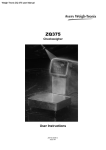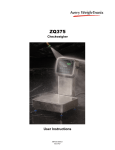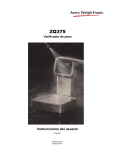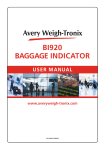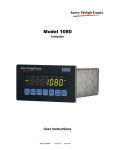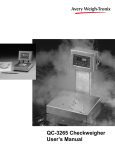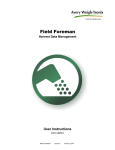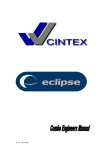Download ZQ375 FAQ - Avery Weigh
Transcript
ZO 375 CHECKWEIGHER Checkweighing solutions for food processing and beyond. Frequently Asked Questions 1. What is NSF ANSI 3-A and why is it important for the food industry? NSF stands for National Sanitation Foundation, ANSI stands for American National Standards Institute and 3-A stands for Sanitary Standards Committee which has its roots in the Dairy industry. These standards are used to monitor and control sanitation through cooperation with federal authorities, manufacturers and users. 3-A criteria is used throughout North America and it is gaining worldwide recognition. NSF/ANSI Standard 3-A 14159-1 -2010 specifically refers to hygiene requirements for the design of Meat and Poultry Processing Equipment. the peaks found within the fine brush finish. This results in a finish that is much easier to clean and prevents bacterial microorganisms from growing on the surface of the scale. An ideal surface finish is under Ra 0.8 μm. Before electropolishing After electropolishing 4. Why use blue feet on the new ZQ375 indicator? 2. What grade of stainless steel is used in the ZQ375? The ZQ375 is manufactured using food grade AISI (American Iron and Steel Institute) 304 stainless steel and finished with a fine brushed surface finish that is under Ra 0.8 μm as specified with in NSF/ANSI Standard 3-A 14159-1 -2010. Using a fine grain brush finish under Ra 0.8 µm helps to stop microorganisms from taking hold and growing on the surface. Cleaning Barrier Level 5. Why is the base flat with open corners? The base structure has a flat bottom to stop unwanted food particles from bouncing up inside the scale base while being high pressure cleaned. Corners of the base are left open to allow any food particles that find their way into the base to be easily washed out during the cleaning process. Microorganism Coarse Surface Finish This is an industrial standard designed to identify foreign objects within foods quickly and easily. The color blue is not normally found within natural foods, allowing the feet to be easily located should they become detached from the scale. Fine Surface Finish 3. What is pickle and electropolish finished and why do we use it on the checkweigher? The main food contact areas where raw food comes in to contact with the stainless steel - such as the weight platter and column - are normally subjected to a pickled and electropolished finish. This helps to remove any impurities on the surface of the stainless steel, while smoothing and rounding 6. Why have we removed the rubber bumpers from under the weight pan? The rubber bumpers have now been incorporated in the breakaway plate. This is intended to aid cleaning and prevent them from becoming loose and falling off. 7. Why have rounded corners on the column, indicator and top pan? Rounded corners improve cleaning and reduce food trap areas while also adding strength and rigidity to the product. ZO375 CHECKWEIGHER Technical Specification 8. How bright is the display in various lighting conditions? 15. How do you enter PLU data? The display on the ZQ375 uses IBN technology; this provides tremendous contrast between its illuminated digits and surrounding background. It is used within the automotive industry to improve viewing in both bright and dimly lit environments. PLU 0 is a free PLU that cannot be stored and allows the operator to set and change target limits. It has a very wide viewing angle to allow the display to be clearly seen by the operator from any angle. 9. What is meant by torsion base design and what advantages does it give over other bench bases? The torsion base is a unique Avery Weigh-Tronix design, which protects the load cell from accidental damage, shock loads and overloading. This design protects the loadcell better than any other bench base on the market today. Based on past data, the failure of the loadcell when used in this base design has resulted in a failure rate of less 0.001% over the last 20 years. 10. What is the main difference between the BSF and BSG base designs? The main difference between the two bases is the load cell accuracy and wash-down protection offered: ›› The Model BSG base uses the same load cells as used on the current torsion bases, is NTEP approved to 3000d and uses a fully stainless steel IP65 (NEMA4x) load cell suitable for some wash-down applications. ›› The Model BSF base offers a high legal-for-trade accuracy of 5000d and is designed for high pressure cleaning to IP69K, making it ideal for food applications. 11. What capacities and resolution are available with the ZQ375? The ZQ375 indicator and base are fully NTEP approved and available in two legal-for-trade accuracies depending upon the base chosen. The ZQ375 linked with the BSG torsion base offers an accuracy of 3000d. When linked to the BSF torsion base or BS diamond, the ZQ375 offers a legal-for-trade accuracy of 5000d. For non legal-for-trade applications, higher resolution and accuracies can be configured. 12. How fast is the ZQ375? The ZQ375 has been designed to be fast, accurate and reliable and in normal working environments will stabilize within 0.6 of a second. This makes the ZQ375 the fastest static checkweigher within the AWTX product offering. 13. How many PLUs does the ZQ375 have? 500 when operated in the advanced application. 14. What types of data can be stored under each PLU? The PLU data can be stored in two ways: ›› Target , Lower Tolerance , Upper Tolerance ›› Low Limit and High Limit. All PLUs from 1 to 500 are entered in the Supervisor mode, which is password protected. A more convenient method is to store the PLUs in a spreadsheet, export the data to a .CSV file and perform a PLU download to the indicator. This is accomplished using Ethernet FTP or through a thumb drive through the USB port via the Supervisor menu. The PLU database can be exported from the ZQ375 in the same fashion. 16. What communication ports and options are available on the ZQ375? Standard: ›› 2 x serial ports ›› USB Host ›› Ethernet Options: (1 option at a time) ›› USB Device Option ›› RS422/RS485/Current Loop Option ›› 802.11b/g Wireless Option 17. Can the weight data be logged into a PC? Yes we can connect to a PC via several different methods: ›› RS232 Serial ›› Ethernet ›› USB Device (optional) ›› Wireless (optional) 18. What distance does the ZQ375 Wireless connection cover? Tests have shown an operational distance of 200 feet (60m) but this will be subject to working environments. 19. What is IP69K? The IP69K rating is used in applications where high pressure & high temperature wash-down is used to sanitize equipment. ›› IP6xx refers to the product’s ability to resist ingress of dust. ›› IPx9K refers to the product’s ability to resist ingress of high temperatures up to 176˚F/ 80˚C and high pressure steam / water at 1160-1450psi / 80-100 bar ›› IP69K is a worldwide recognized standard which defines the ingress protection of the enclosure base and external options. The ZQ375 stainless steel has been third party IP69K (IEC 60529) certified by TRAC Labs. Do not be misled by brands that state their products are designed or equal to IP69K without certification. 20. In addition to the ingress protection IP69K provides, is there a solution for internal condensation that may occur when a cold stainless steel enclosure is subjected to hot steamy water during a cleaning cycle? Each stainless steel IP69K enclosure includes a patented air pressure equalizing solution. 21. What is IP65 (NEMA4X)? ›› IP6x refers to the product’s ability to resist ingress of dust. ›› IPx5 refers to protection against low pressure water jets from any direction. Limited ingress is permitted. ›› NEMA4X means the product is watertight, dust tight, and corrosion resistant (for Indoor/Outdoor use) 29. Is the IP69K rechargeable battery pack a serviceable item? 22. How resilient is the keyboard to operator misuse? 30. What power source is required? Designed for the food industry, the ZQ375 has a flat easy-to-clean audible key pad and an extra thick outer layer to protect the keypad from occasional knife abuse. This overlay construction has been tested to over 1 million knife presses without any failures occurring. The ZQ375 utilizes a universal medical grade PSU, designed to auto switch for voltage ranges between 110VAC to 240VAC 50 or 60 Hz. 23. Can an external light stack be used with the ZQ375? The ZQ375 offers an optional external OPTO22 relay box that fits neatly within the rear of the column. And optional DC light stack can easily be attached to this box making it a quick and easy option to install. Designed to be fully serviceable, this IP69K rechargeable battery pack runs from a standard off-the-shelf lead acid 6V battery. The battery can easily be replaced by removing the service plate found on the underside of the battery. 31. What connectivity comes as standard? Rs232, USB host and Ethernet are standard and can be hard wired through one of the glands on the bottom of the indicator. A removable wash-down USB or Ethernet gland can be retrofitted in place of the big gland on the bottom of the indicator, if required. Only one wash down gland can be installed due to space restraints. 32. What is USB host and USB Device? 24. Can the light stack be used with the ZQ battery pack? No. Only one external option can be used. The OPTO22 relay box fits in the same location as the ZQ battery pack. 25. How many waterproof quick connect glands can be fitted to the ZQ375? Only one USB or Ethernet waterproof quick connect gland can be used on the ZQ375. If the customer requires both, one can be hard wired inside the indicator and they can also use one of the fixed glands provided on the base of the indicator. 26. What battery is in the ZQ battery pack? Designed for serviceability, the ZQ battery pack uses a standard off-the-shelf 6V lead acid battery. 27. What IP rating is the battery pack? IP69K approved and designed for use within the food industry, the battery pack fits neatly within the rear of the column to allow easy removal for cleaning or recharging. The ZQ375 comes standard with USB host, allowing data to be simply and quickly transmitted to printers and data transfer to thumb drives. The addition of a USB Device option card enables simple transmission of data when inputting data from a PC, or controlling the checkweigher remotely. This can also be done using the Ethernet port, which is standard on all ZQ375 checkweighers. 33. Can the checkweigher be controlled from an external database? Yes. Using the SMA protocol, the ZQ375 checkweigher allows PLUs to be selected remotely. This feature allows lines to be set remotely from the supervisor’s office. 34. Can the new column be used on the old Torsion base and vice versa? Yes. The new open backed torsion base column has been specially designed to remove all food trap areas. The use of thicker, foodgrade 304 stainless steel helps to guarantee strength and rigidity at all times, while keeping the same base clamping hole positions used on the old torsion base to ensure compatibility between old and new bases and the new ZQ375 checkweigher column. 35. What is an IBN display? 28. How long will the battery last in the ZQ375, how is the battery charged and how long does it take to charge the battery? It is designed to give up to 16 hours of use between recharges and can be recharged remotely in 8 hours. It has mainly been designed for external recharging, allowing customers to have more than one battery per scale. For applications where power outage is a regular occurrence, the battery can be wired to allow recharging to take place within the scale. This display technology provides tremendous contrast between its illuminated digits and surrounding background. It is used within the automotive industry to improve viewing in both bright and dimly lit environments.. 36. How do you configure the set up parameters for the indicator? The indicator can be configured through a sequence of key presses on the front panel or through the use of the PC support software program Ztools. ZO375 CHECKWEIGHER Technical Specification 37. Can communication output strings be changed? The selected application suite includes a default print string and protocol, but these can be enhanced or modified through the front panel or by using Ztools. For ease of configuration we recommend the use of Ztools (PC software program). 38. Can the new IP69K loadcell be fitted into the old torsion bases? No. Due to the size and hole patterns of the new IP69K loadcell, it will not automatically fit in to the old torsion base design. 39. The loadcell on the old torsion base design was very expensive to replace. Will it be the same on this new loadcell? The old design required complete loadcell assembly with spacers to be replaced. The new design means only the loadcell itself has to be replaced, resulting in cheaper serviceable components. Avery Weigh-Tronix - USA 1000 Armstrong Drive, Fairmont, MN 56031-1439 USA [email protected] Toll-Free: (800) 533-0456 Phone: (507) 238-4461 Avery Weigh-Tronix - UK Foundry Lane, Smethwick, West Midlands B66 2LP UK [email protected] Phone: +44 (0) 8453 66 77 88 Fax: +44 (0) 121 224 8183 Please call us or visit www.averyweigh-tronix.com © Avery Weigh-Tronix group of companies 2012. All rights reserved. Avery Weigh-Tronix is a registered trade mark of the Avery Weigh-Tronix group of companies. This publication is issued to provide outline information only which, unless agreed by an Avery Weigh-Tronix group company in writing, may not be regarded as a representation relating to the products or services concerned. This publication was correct at the time of going to print however, Avery Weigh-Tronix reserves the right to alter without notice the specification, design, price or conditions of supply of any product or service at any time. V1 zq300series_faq_500855.indd (C&D) AWT35-500855




